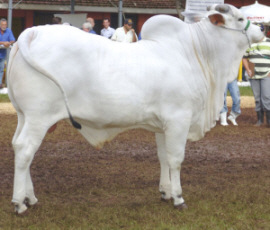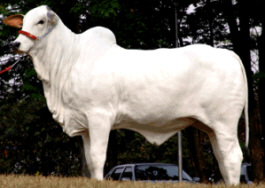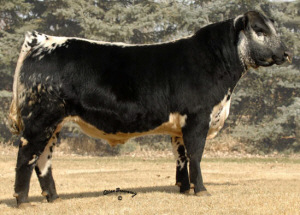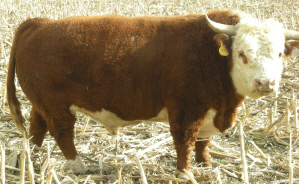



Nelore
History
The Nelore origins date back over 2000 years when the Aryan people brought the ancestors of this breed to India. These ancestors were called Ongole, the change of name to Nelore (which corresponds to a district of the old Presidency of Madrás, now belonging to the new State of Andra, by the Bengal Sea) happened in Brazil by some authors as a synonym to Ongole. |
The Nelore was first acknowledged in Brazil in 1868, when a ship on its way to England carrying two Ongoles stopped in Salvador, Bahia, and the animals were sold. Ten years later, a breeder from Rio de Janeiro, named Manoel Ubelhart Lemgruber, bought another couple from the Hamburg Zoo in Germany. Then the Nelore breed expanded gradually, first in Rio de Janeiro and Bahia, then in Minas Gerais, having reached Uberaba in 1875.
The creation of the Nelore Herd Book and the definition of the breed standards in Uberaba, 1938, was of great relevance in the formation of the Nelore. In 1960, 20 animals were imported, and in 1962, the last and most relevant purchase of live animals from India authorised by the Brazilian Government, 84 Ongoles were imported. These became founders of important breeding lines like Godahvari, Karvadi and Taj Mahal, and were decisive to the great expansion of the Brazilian herd in the last 30 years, going from 56 million in 1965 to 160 million in 1995, 100 million of which are Nelore.
Today, the number of purebred registered Nelore is above 5 million. The challenge faced by selection is to multiply the genetic gains to a much larger population. To multiply the genetic potential of Nelore sires, Artificial Insemination is being used in large scale since the 60’s. Sales of Nelore semen represent 65% of the AI market of all beef breeds in Brazil. The leading Nelore sire there produced and sold 34,000 straws of semen in 1995, followed by another Nelore that sold 30,000, which means that both sires must have bred more than 20,000 cows.
Characteristics
The Nelore is of the Bos indicus species and has the characteristic hump above its shoulders and loose skin. It is usually white in colour with a black skin, muzzle and tail, and they have comparatively long legs which helped them walk in water when grazing. Nelore have the shortest ears of most Bos indicus types. The Nelore are horned, these are thick brown horns that point up but there is a naturally polled strain of the breed too.The Nelore has heat and insect resistance due to its loose, thick black skin and covering of white hair which reflects the suns rays, this breed has sweat glands that are twice as big and 30% more numerous compared to european breeds. It has a slow metabolism which creates less heat and enables it to feed less often adding to its high resistance to bloat.
Nelores have long, deep bodies with clear underlines, keeping vulnerable parts out of the way of infection. Cows have small udders and short teats, while bulls' sheaths are also short. These characteristics contribute to the breed’s reproductive efficiency. Nelore dams have a long and prolific reproductive life, pronounced mothering ability, and plenty of milk for their calves. The Nelore cows calve very easily due to their greater frame, wide pelvic opening and larger birth canal, which reduces the incidence of distocia.
Every registered Nelore sire is the outcome of a complex process of selection. Breeders receive assistance from a nationwide association, the Associação Brasileira dos Criadores de Zebu or ABCZ. Birth weight, weaning weight, yearling weight, scrotal circumference, are some of the traits measured. Research centers and universities calculate EPDs (Expected Progeny Difference), making the results available to breeders to support their selection decisions.
 Photo courtesy of Associação dos Criadores de Nelore do Brasil, www.nelore.org.br |
Statistics
Comparative
The polled type is genetically dominant over the horned type, when a horned dam is bred to a polled sire or a polled dam is bred by a horned sire, approximately 85-90% of the offspring will be genetically polled.In research done by the U.S. Meat Animal Research Center in Nebraska, the Nelore F1s showed the largest percentage of unassisted calving, the highest weaning percentage, and their offspring calves were 2nd in 200-day weaning weight of the 11 breeds evaluated. These results combined placed the Nelore F1s as the most productive dams, with an impressive 115.0 ratio.
Distribution
Brazil has become the largest breeder of Nelore, and from there the breed was exported to Argentina, Paraguay, Venezuela, Central America, Mexico, United States and many other countries.References (the above information was cited from the following sites)
www.ansi.okstate.edu
www.nelore.org.br


